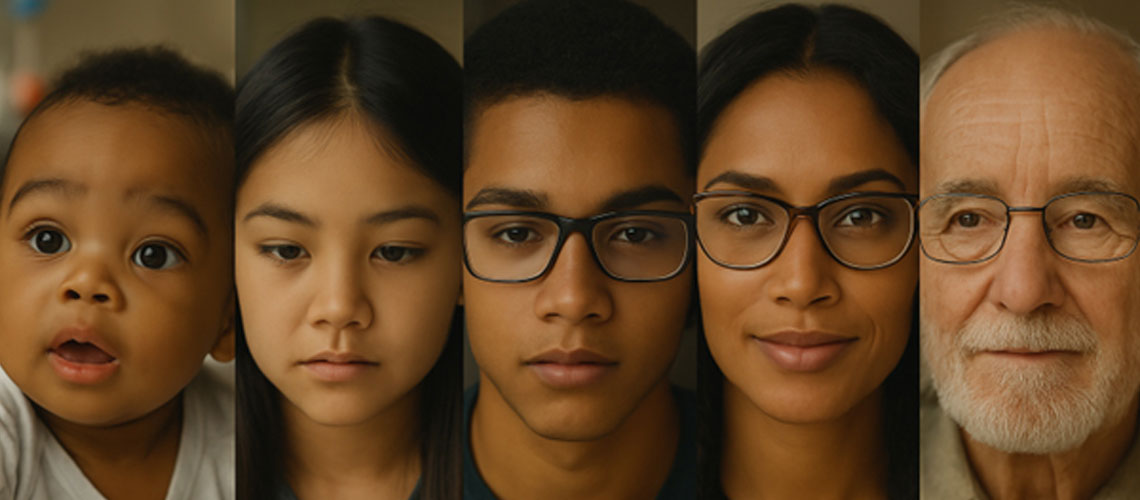VISION THROUGH THE AGES
 |
||||
|
From the moment we open our eyes as newborns to the challenges of age-related visual decline in later years, the journey of eyesight is a remarkable testament to the complex sense of sight. Vision evolves and changes throughout our lives, adapting to the needs and challenges of each life stage and shaping how we perceive the world around us. Understanding how our eyesight changes over time can help us protect and optimise it, ensuring clear vision and eye health at every age. INFANCY
Newborns enter the world with limited vision. They are able to focus on objects only about 20 to 30 centimetres away, just enough to see their caregiver’s face during feeding and bonding. In the first few weeks the baby appears to be cross-eyed as the eyes learn to work together. Over the first few months of life, the visual system develops rapidly. By 6 months of age most babies have achieved visual acuity, eye coordination, depth perception and the ability to track moving objects, skills that are crucial for the development of hand-eye coordination. Newborn babies are unable to perceive colour, and it takes a few months for colour vision to develop. Infancy and early childhood are critical periods for eye health. If not detected and treated early, eye problems at this stage can lead to developmental problems. An eye examination at six months of age involves observing how the eyes react to light, work together and are able to follow a moving object, ensuring that vision is developing as it should be. |
||||
|
THE PRESCHOOL YEARS
During the toddler and preschool years, children’s visual abilities continue to advance rapidly, as they explore and learn about their environment and develop the skills that they will use at school and throughout their lives. It is a time of establishing the foundations of reading, writing and mathematics. They become more adept at distinguishing colours, shapes, and patterns, and consolidating both gross and fine motor skills as their hand-eye coordination and body movements improve. Activities such as reading books with vibrant illustrations or playing with puzzles and construction toys can stimulate their visual development and cognitive skills. |
||||
|
SCHOOL-AGE VISION
During the school years, children’s vision plays a vital role in learning and development. As they progress through their education and face increasing demands on their visual skills, children depend on their vision to function effectively both in the classroom, on the sports field and in their social activities. Vision skills needed for school include visual acuity, eye focusing, eye teaming, eye tracking, eye-hand coordination, visual recognition and discrimination, and the ability to understand, remember and respond to visual stimuli. When certain visual skills have not developed, or are poorly developed, learning is difficult and stressful. Undiagnosed problems with vision can affect academic performance as well as social and emotional development. Myopia, shortsightedness, often emerges during this period, and with increasing screen time it is on the rise. A child may be unaware that he has a problem with his eyes, or be unable to express it, so parents and teachers need to be alert to the signs that a problem exists. |
||||
|
ADOLESCENCE AND YOUNG ADULTHOOD
Just like the body, the eyes continue to grow and change during this stage of life. It is the time when visual acuity, reaction times and eye coordination reach their peak, but also a time when problems such as myopia diagnosed earlier may worsen and prescriptions may need to be changed frequently. The prescription usually stabilises around the mid-twenties. Increased use of digital devices may lead to symptoms of computer vision syndrome, such as tired eyes, eye strain, irritation, blurred vision and headaches. To reduce these effects, screen time should be balanced with ‘green’ time, time spent outdoors. For teenagers and young adults, contact lenses, sports goggles, or protective eyewear may become essential, especially for those involved in sports or high-risk activities. |
||||
|
40 PLUS: THE TRANSITION BEGINS
In the 40s, vision may start to change subtly as many people begin to notice difficulty focusing on near objects, trying to compensate by holding reading material further away in an attempt to focus more clearly. This is due to the natural aging process of the lens of the eyes. Hormonal changes or increased screen use during this period may result in dry eyes. Maintaining good eye health becomes increasingly important as we age. This is a critical time to have regular eye examinations to detect or start monitoring the early signs of eye conditions such as cataracts, glaucoma and age-related macular degeneration. |
||||
|
SENIOR YEARS
Age-related vision decline is an inevitable aspect of aging and a time when the risk of age-related eye conditions increases significantly. As we grow older, various changes occur in the eyes, leading to decreased visual acuity, depth perception and contrast sensitivity, which can affect mobility and independence. Additional changes in overall health and development of other health conditions can add to the deterioration of visual health. Regular eye examinations become even more important to detect and manage conditions that could lead to vision loss. |
||||
|
Vision evolves with each stage of life. While visual changes are inevitable, adopting a healthy lifestyle can help to preserve vision and eye health. Maintain a diet rich in eye-healthy nutrients, such as omega-3 fatty acids, lutein, zeaxanthin and vitamins A, C and E. Protect the eyes against the damaging ultraviolet rays of the sun. Monitor screen time. Stay active; regular exercise improves blood flow to the eyes, helping maintain healthy vision. Schedule regular eye examinations. |
||||






